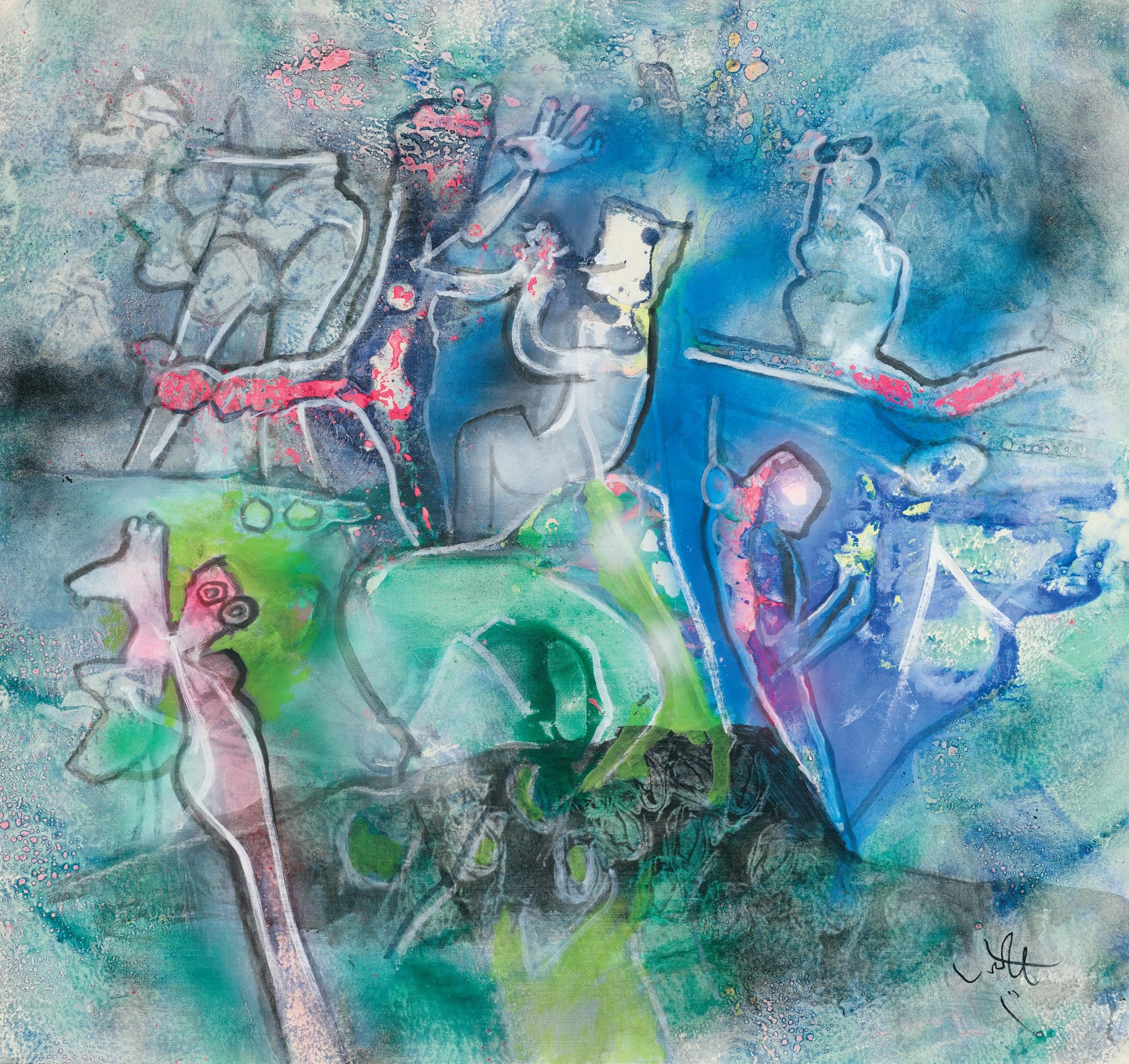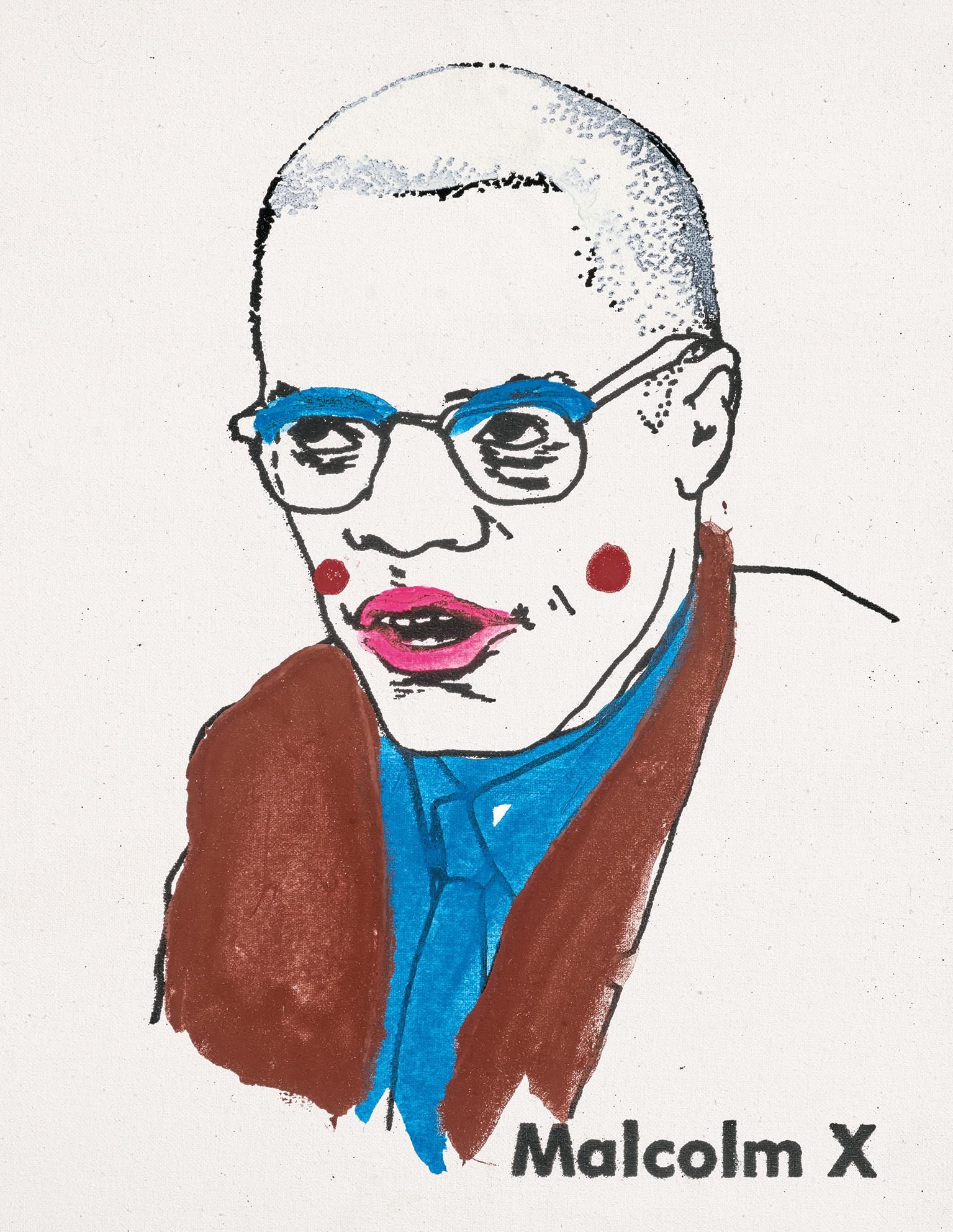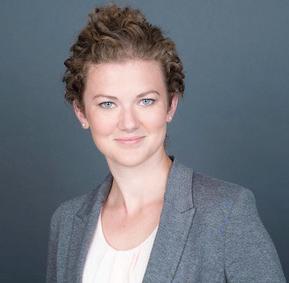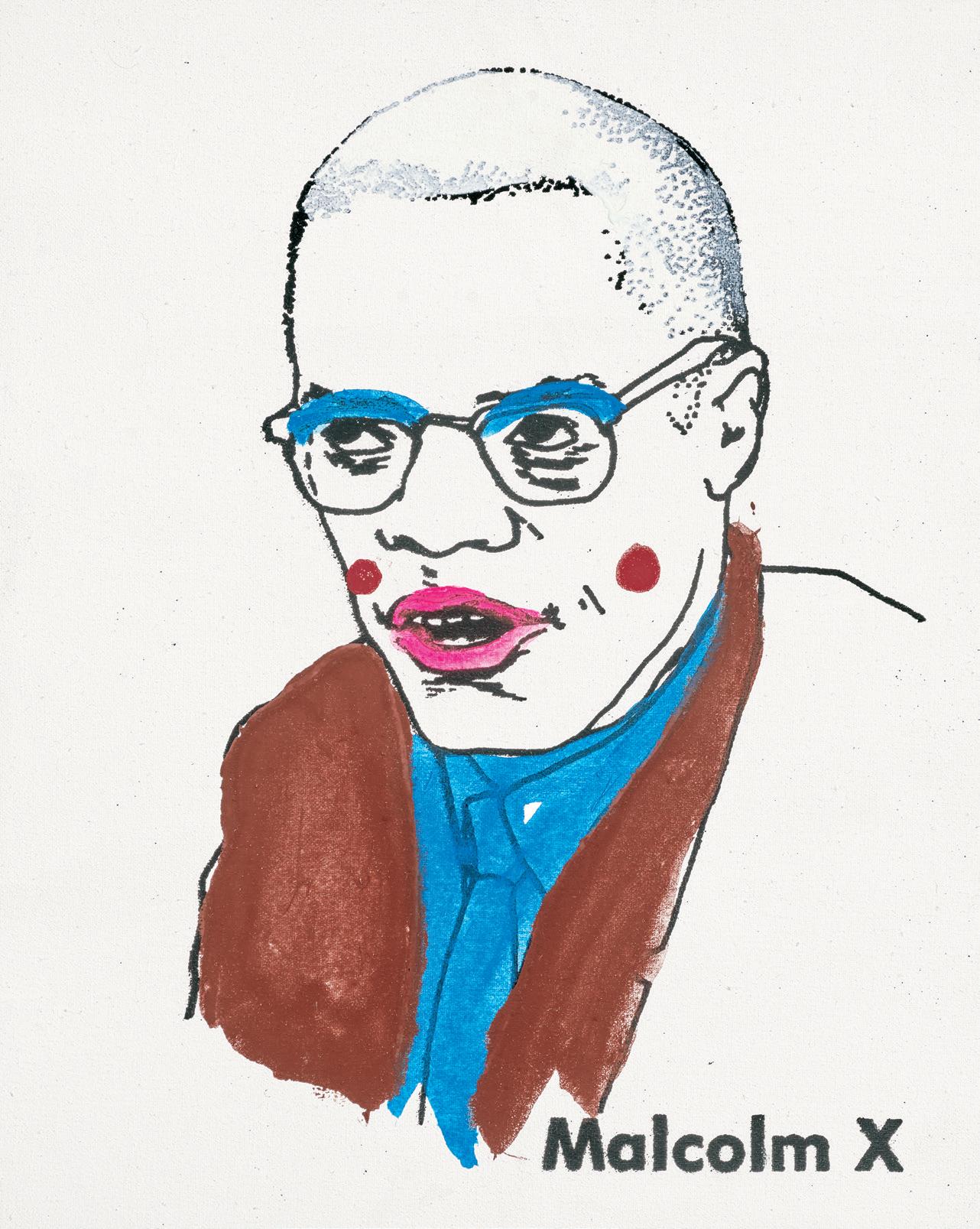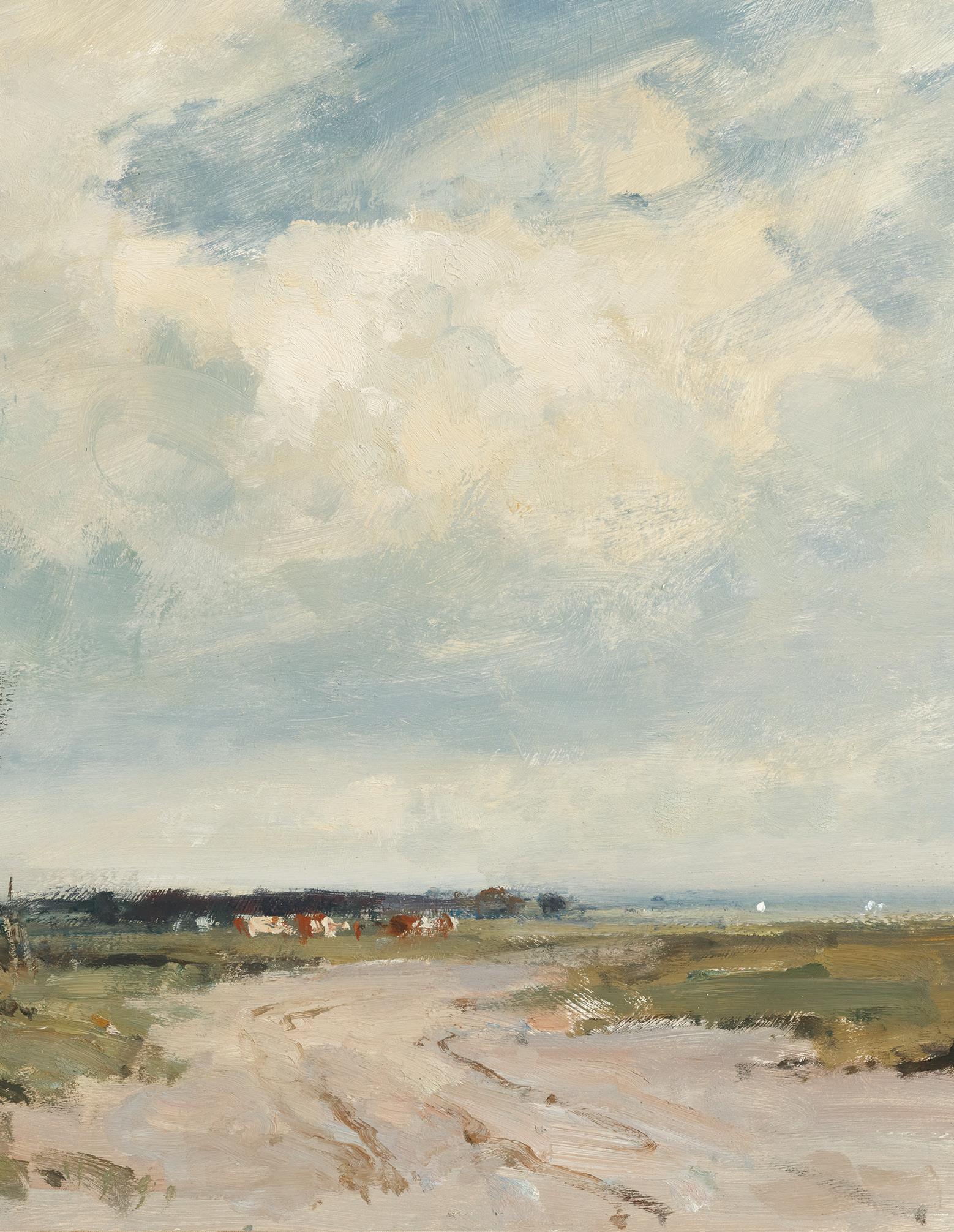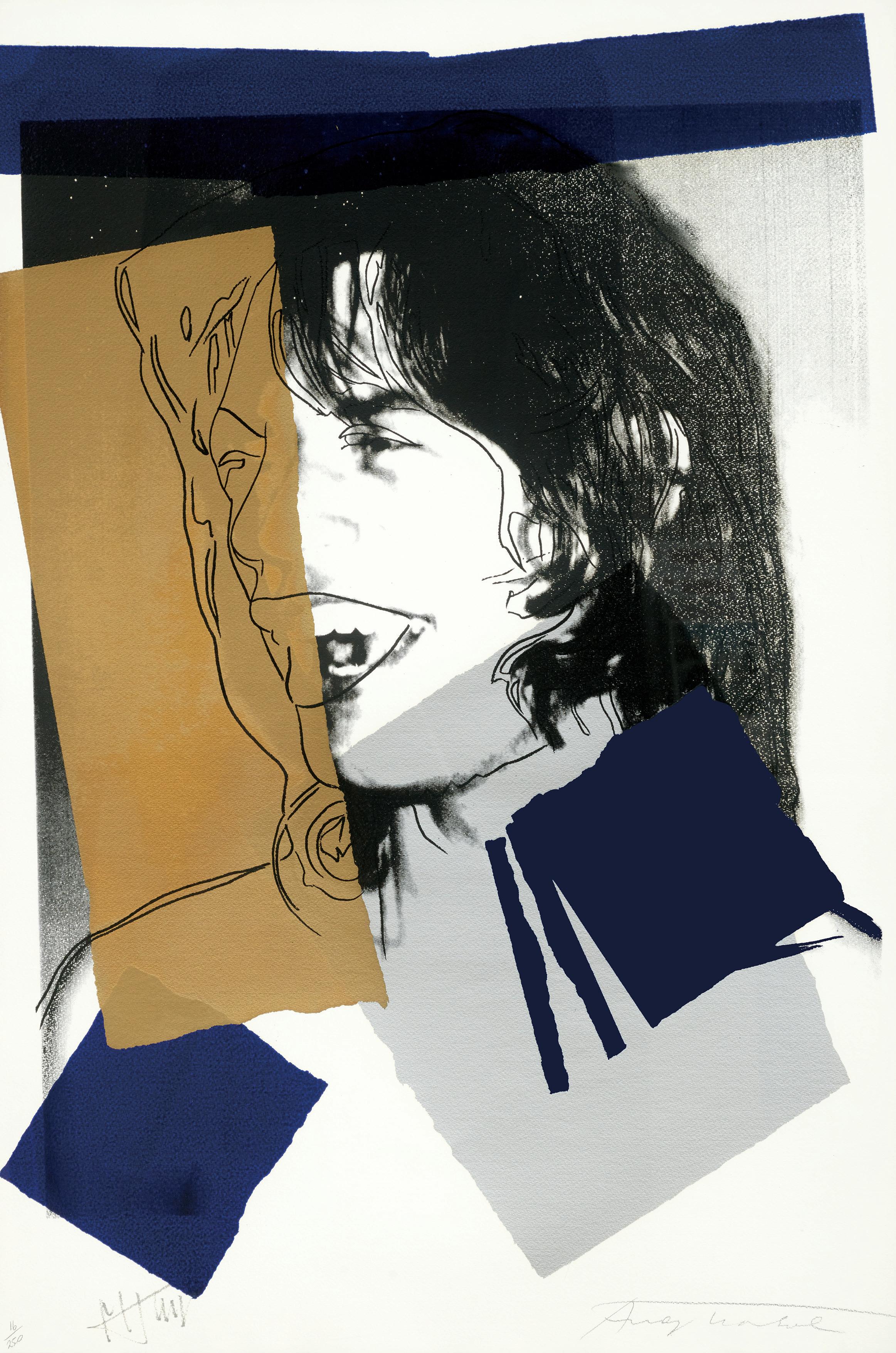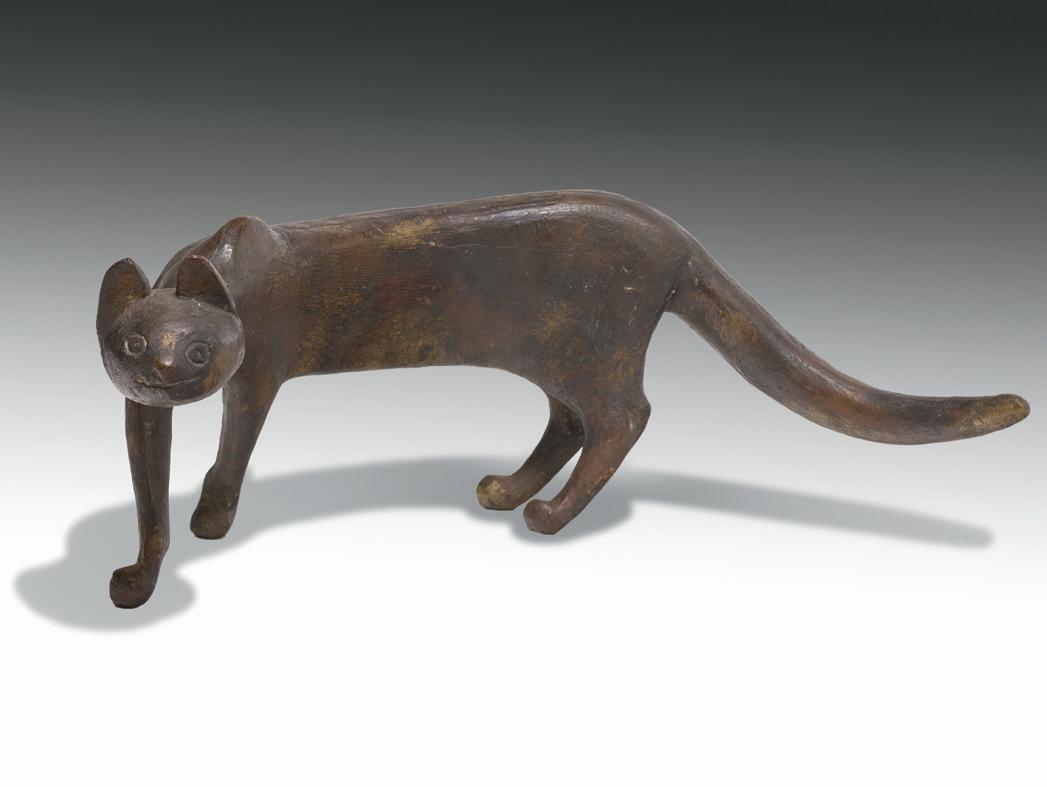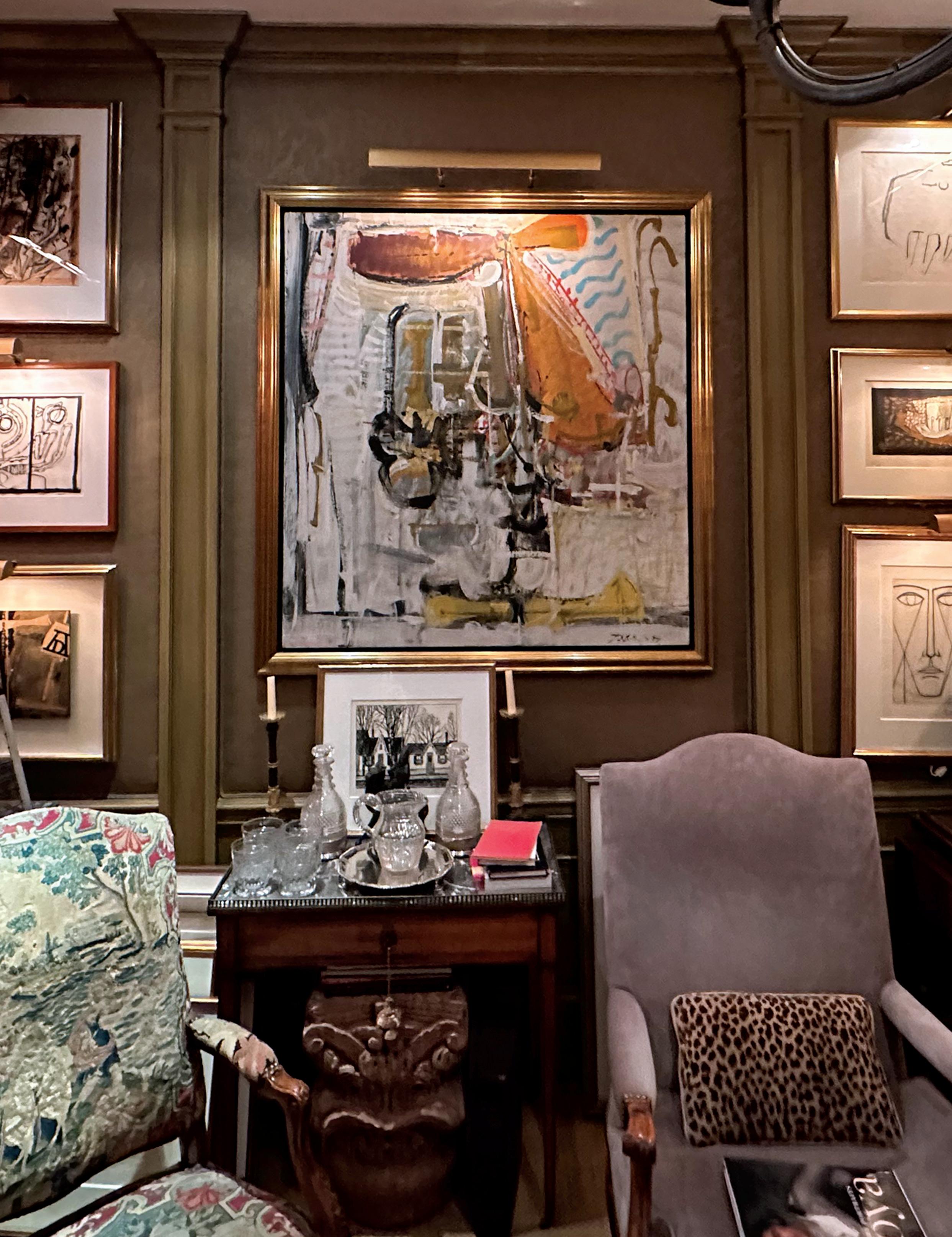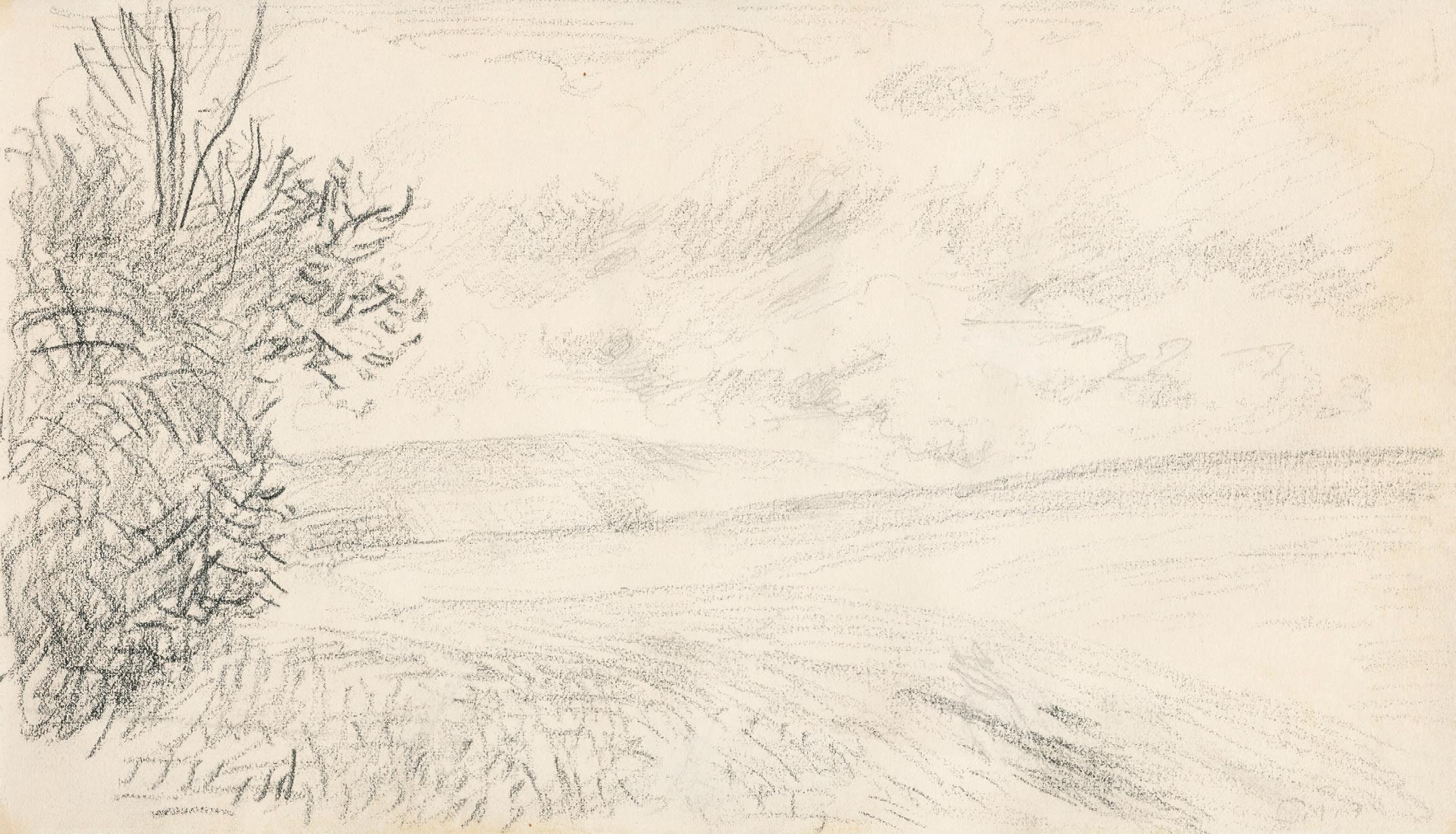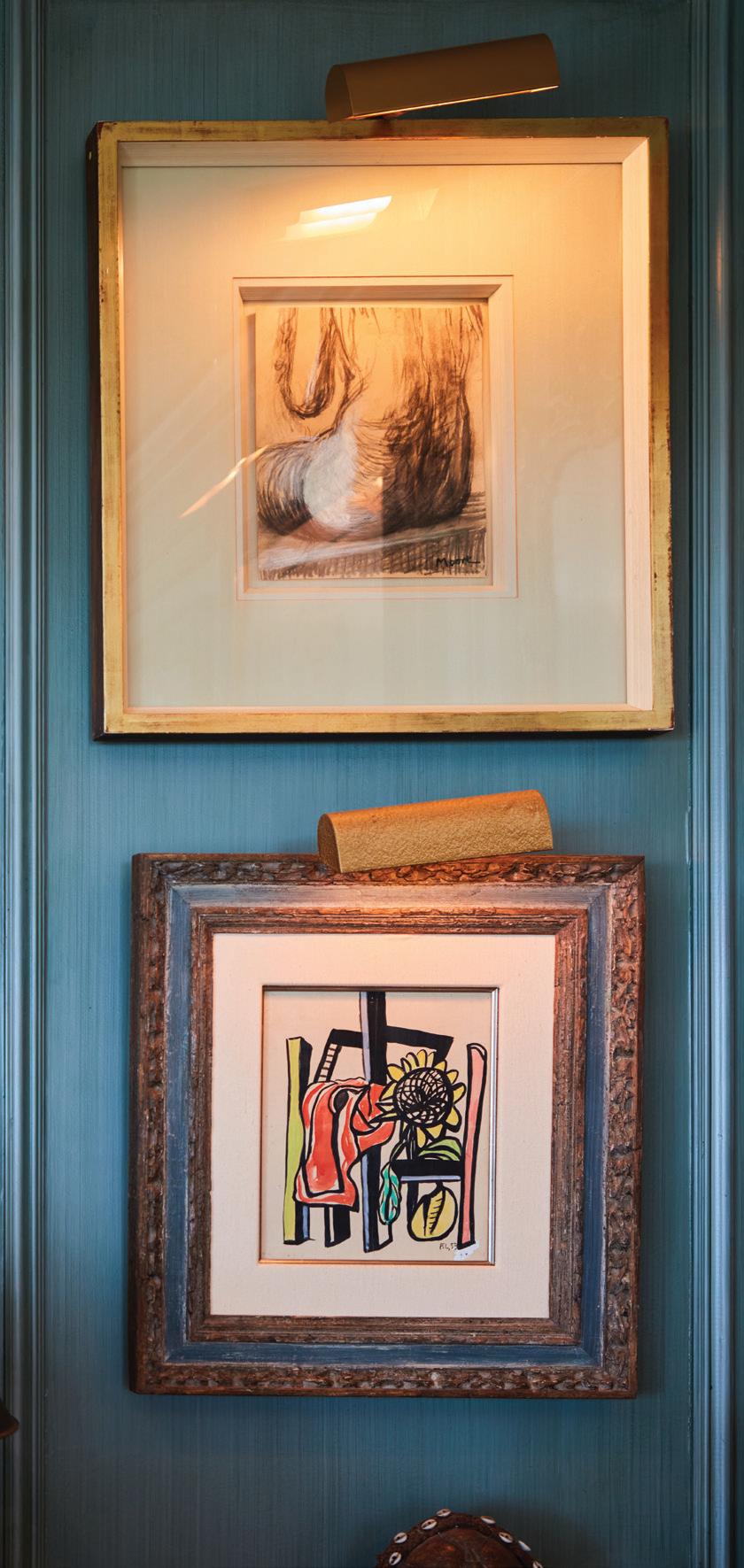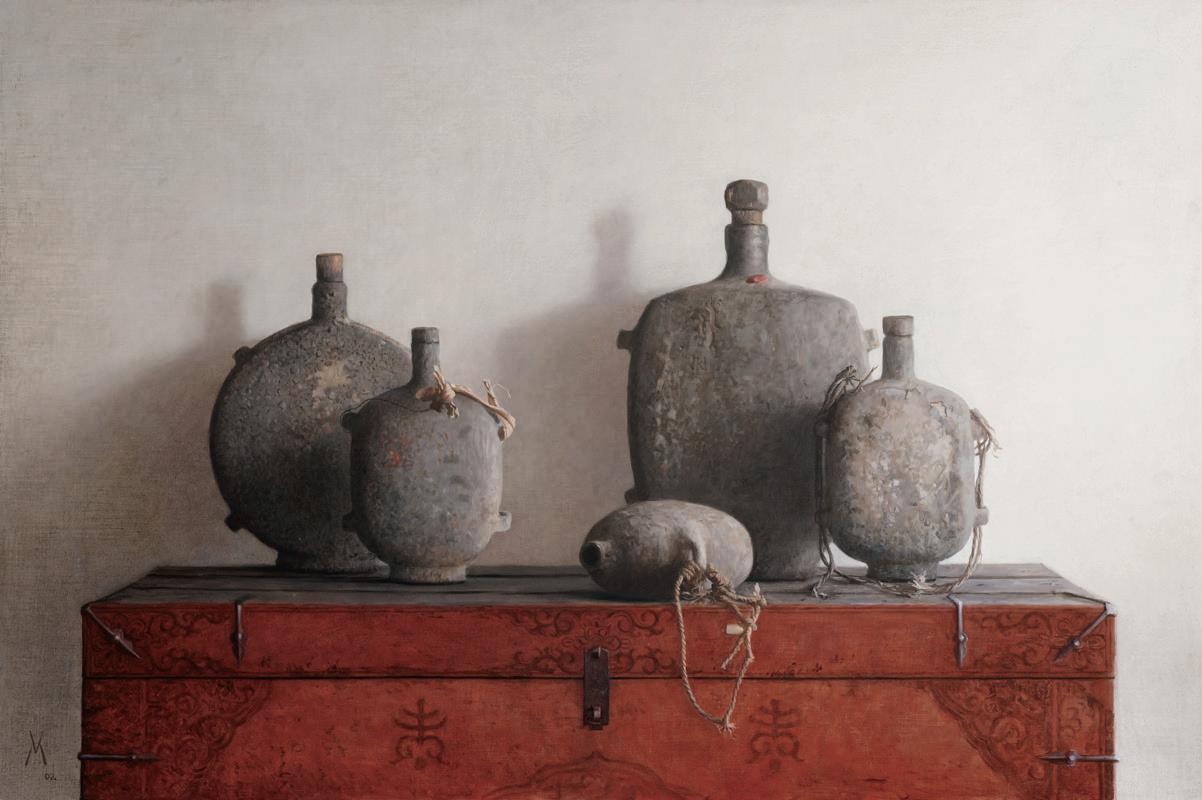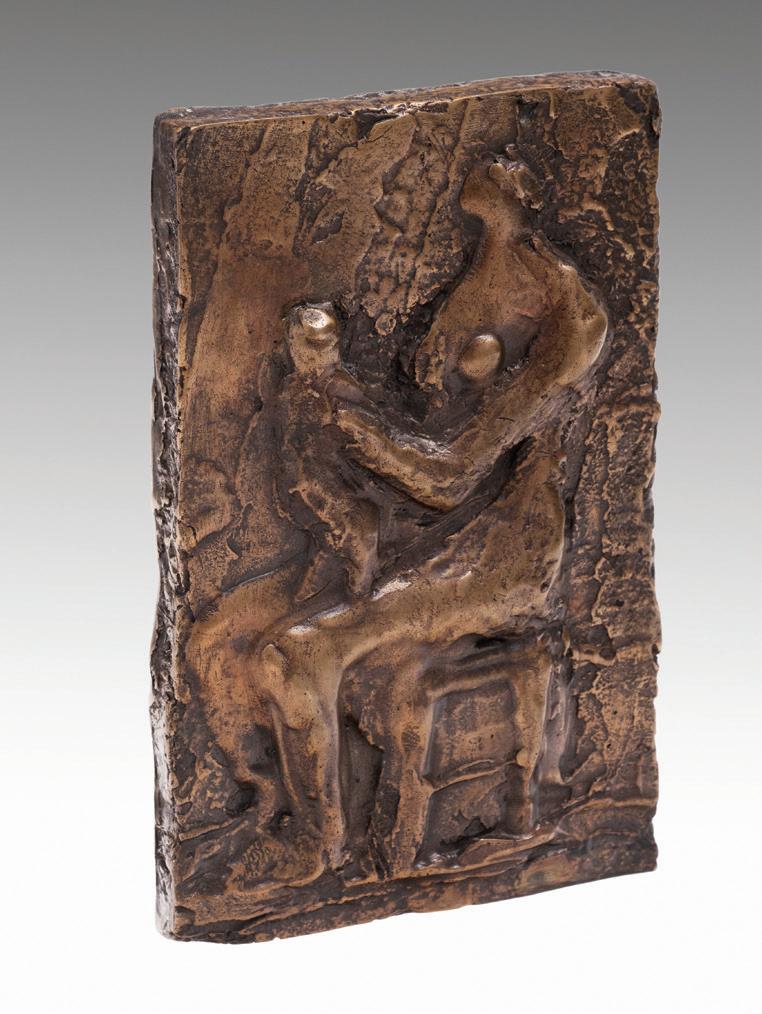WORKS
ROY LICHTENSTEIN
This Must Be the Place (Corlett III.20), 1965
colour of set lithograph on wove paper printed signature, dated 1965 (as issued) and signed in the lower margin; titled and dated on a gallery label on the backing on the reverse. From an unknown edition size. Published by Leo Castelli Gallery, New York 21.38 ins x 16 ins; 54.3 cms x 40.6 cms (image)
PROVENANCE
Paul Petro Contemporary Art, Toronto Private Collection, Toronto
LITERATURE
Mary Lee Corlett, T e Prints of Roy Lichtenstein: A Catalogue Raisonné, 1948-1997, Manchester, 2000, page 300, catalogue no. Corlett III.20
Roy Lichtenstein had already established himself as a cutting-edge artist, regularly exhibiting with Leo Castelli by the time he was asked to create T is Must Be the Place as a promotional poster. Te futuristic cityscape Lichtenstein has represented is loosely based on the skyline of New York City, where the National Cartoonists Society 19th Annual Reuben Awards dinner was held at the Plaza Hotel in April 1965.
According to Mary Lee Corlett, “An undated NCS press release (found in the New York Public Library clipping f les) indicates that it was f rst published as a poster by the Society. Shortly thereafter the Leo Castelli Gallery republished the image as this print. Te press release states: ‘ Te Castelli Gallery in New York has arranged for a special limited edition of the drawing for the NCS poster, printed from the same plates, that will be sold at the Gallery for $15 a print’.”
For T is Must Be the Place, Lichtenstein has returned to one of his most enduring colour schemes: red, yellow, blue and black f lled with Benday dots. Te remains of a rocket stream are visible at the top edge with the title of the work, mimicking a speech bubble commonly found in comic books, which Lichtenstein drew from for inspiration.
$15,000–$25,000
54
FRANCIS BACON
colour lithograph on Arches wove paper signed and numbered 120/150 in the lower margin; titled “Untitled” on a gallery label on the reverse. Executed in 1971. Published by Musée du Grand Palais, Paris, on the occasion of the artist's retrospective exhibition in 1971
63 ins x 47.25 ins; 160 cms x 120 cms
PROVENANCE
Marlborough-Godard, Toronto Private Collection, Toronto
LITERATURE
Bruno Sabatier, Francis Bacon: T e Graphic Work, Paris, 2012, catalogue no. 10
Mark Stevens and Annalyn Swan, Francis Bacon: Revelations, New York, 2020, page 519
T is work was inspired by Francis Bacon’s triptych of bull f ght paintings from 1969, in which he celebrates this ancient ritual that remains popular in Spain, Portugal, and southern France. T is colour lithograph was initially issued as the main image on the poster advertising Bacon’s retrospective of paintings in October 1971 at the
Grand Palais in Paris. His close friend, the French author Michel Leiris, also appreciated bull f ghts and had sent Bacon in 1966 a copy of his novel Miroir de la tauromachie (Mirror of Bull f ghting), which would have spurred the artist to return to this motif.
Bacon’s characteristic fusion of f gures, amalgamation of colours, and dynamic action are on full display to represent the tussle between a raging bull and a matador. Te f gure stands upright with one leg held up in triumph above what appears to be a bull’s horn. Te man and the animal are nearly indistinguishable: the fesh-coloured tones merging with shades of brown, white, gray and crimson red. Despite the simplicity of the scene in the foreground—to better showcase the f ght—a rectangular panel in the background inevitably draws the viewer’s eye. Only upon a closer examination does one realize that the indistinct mass of forms represents a crowd of howling spectators. Te large throng ultimately breaks the rhythm of the sandy ground of the outdoor setting as well as the orange backdrop, reminiscent of the corrida Bacon would have encountered in his travels.
His series of bull f ght scenes pay homage to Bacon’s enduring interest in exploring the intersection of human and animal, of the wild brutality that animates all of us. By capturing the beauty within the liminal state between life and death, the Irish-born artist ofers a poignant meditation on the true nature of mankind.
$30,000–$40,000
55
GLENN LIGON
Small Malcolm, 2006
vinyl-based paint, silkscreen ink and gesso on canvas laid on board signed, titled, inscribed “For Wayne with Much Love XO, Glenn” and dated 2006 twice on the reverse; unframed 10 ins x 8 ins; 25.4 cms x 20.3 cms
PROVENANCE
Gift of the Artist
Private Collection, Calgary
LITERATURE
Lauri Firstenberg, “Neo-Archival and Textual Modes of Production: An Interview with Glenn Ligon,” Art Journal, Spring 2001, page 47
Born in 1960, the American artist Glenn Ligon combines painting, photography, printmaking and conceptual practices to address issues of racial and sexual identity in his work. In a 2001 interview, Ligon described the Colouring Book project: “I was interested in expanding the range of material that I was using for my paintings to include more image-based source material. Black-themed coloring books from the seventies fascinated me because they were so clearly linked with the project of Black liberation. Any depiction of a Black person, from
Malcolm X to a boy swinging on a tire, was a little revolution because it meant that our histories, stories, images and heroes mattered. But our relationship to all that material is quite di ferent now and I wanted to think about that historical distance and issues of engagement and indi ference.”
Te Colouring Book series was a project executed by the artist during a residency at the Walker Art Center in 2000. Ligon wanted to see the reactions of the children who were given these Afrocentric colouring books from the 1960s and 1970s. After all, the f gures depicted were largely unknown to them. In Small Malcolm , the African American civil rights leader has been turned into a clown-like f gure with pink lips, rosy cheeks and white hair. Ligon transforms images and words through reproduction and repetition, which became intrinsic to his practice.
Despite the repeated image of Malcolm X remaining the same, he is transformed, as each coloured work was created by a di ferent hand, thus becoming a unique work of art. As Ligon explained: “I decided to give the coloring book images to kids from three to nine years old, from all backgrounds, to color on them, then I made paintings based on their drawings. In essence, I commissioned my own source material.”
$70,000–$90,000
to the Ramones in 1984 and would later recall: “I saw them live in 1988 and 1989 and the shows were non-stop blistering action.”
SHEPARD FAIREY
Johnny Ramone, 2016 stencil, silkscreen and collage on canvas signed and dated 2016 lower right; titled and dated on a gallery label on the stretcher on the reverse 42 ins x 30 ins; 106.7 cms x 76.2 cms
PROVENANCE
Yves Laroche Gallery, Montreal Private Collection, Toronto
EXHIBITED
Hey! Ho! Let's Go: T e Ramones and the Birth of Punk, Queens Museum, New York, 10 April-31 July 2016
LITERATURE
Shepard Fairey, Johnny Ramone, Obey Giant, https://obeygiant.com/ prints/johnny-ramone
As one of Shepard Fairey’s favourite groups of all time, the Ramones enjoy an enviable place within the artist’s eclectic oeuvre. He has done portraits of each of the four original members. Fairey started listening
Even though Fairey saw the Ramones three times live, in the end, it was the show at the Living Room in Providence, Rhode Island, in the fall of 1988 that he describes as the most intense: “ Te Living Room should have held 500, but in Providence clubs paid of the cops and there were probably 1,000 people in the venue… Te Ramones played non-stop, no breaks between songs for about two hours. Te band was super tight. Johnny leaned into the crowd and didn’t even take his leather jacket of for an hour even though it was sweaty as hell in there.”
Fairey was asked to design a logo for the Johnny Ramone Army, an organization which acts on behalf of the guitarist’s estate. Te American artist was subsequently asked to make a f ne art piece of the illustration, which was issued as a poster. Te artist has used his characteristic mixed media techniques to capture the aggressive stance of the rhythm guitarist mid-downstroke. Fairey has incorporated decorative symbols, text about the band and emblems surrounding Johnny Ramone to create a vibrant energy that best represents the iconic musician.
$40,000–$60,000
57
EDWARD BRIAN SEAGO
Shepherds Hut on the Panoramica, Costa Smeralda oil on masonite signed lower left; titled on the reverse 20 ins x 29.5 ins; 50.8 cms x 74.9 cms
PROVENANCE
Private Collection, Toronto
LITERATURE
James W. Reid, Edward Seago: T e Landscape Art, London, 1991, page 205
Following the end of the Second World War, Edward Seago began exploring far-fung painting grounds, f rst in his small sailboat, then in his yacht Capricorn , discovering northern France and Holland, and eventually on the Royal Yacht Britannia and later by air. He worked briefy in various parts of Italy, from Rome to Lake Como, Venice, Chioggia, Sardinia and Corsica. In 1968, Seago purchased a villa apartment at Porto Cervo in Sardinia, a stylish yachting resort located between Olbia and Arzachena known as the Costa Smeralda. He later purchased the apartment above to be converted into a studio, and his terrace ofered an unobstructed view of the harbour and the jetty.
As in the present work, Seago’s paintings of Sardinia are both cheerful and tranquil, evoking the relaxed spirit of the island. Te brilliant white and vivid blue of the sky stretch into the distance while juxtaposing with the more earthy tones surrounding the little hut in the foreground. Te composition seems almost efortless, capturing the light and atmosphere surrounding the scenery in efcient brushstrokes. After all, Seago was fascinated by the socalled “‘in-between’ times of day, those moments of transition and metamorphosis fraught with mystery when the sharply def ned contours of the day are softened in that evening light which evokes the magic of the Mediterranean world—of Scylla and Charybdis to the south, of the Levant to the East.” Under Seago’s brush, this vignette of land, sea, and sky is transformed into a contemplative meditation on the simplicity of life and the breathtaking beauty of nature.
$25,000–$35,000 58
EDWARD BRIAN SEAGO
Fleet Dyke, Ludham-Norfolk oil on masonite signed lower left; titled on the reverse 22 ins x 36 ins; 55.9 cms x 91.4 cms
PROVENANCE
Laing Galleries, Toronto
Private Collection, Toronto
EXHIBITED
Edward Seago, Laing Galleries, Toronto, May 1967, no. 11
LITERATURE
Edward Seago, A Canvas to Cover, London, 1947, page 133
In this vast and atmospheric landscape, the composition is divided between light and dark: a pale blue sky with passing banks of clouds overlooks a spacious landscape in which cattle can be glimpsed grazing in the distance. Edward Seago’s oeuvre is characterized by the interaction of the sky, the land and the sea, which testi fes to the profound attachment that he and other Norwich School artists had for East Anglia. Te cool tones and patches of light found in Norfolk and Su folk fascinated these artists, who drew inspiration from the simplicity of everyday country life. As Seago describes: “ T at is where each of us must go… right to the very beginning, in the very smallest things.”
Similar to the Romantic landscape artists John Constable, Joseph Mallord William Turner and Richard Parkes Bonington, Seago learned to derive the subject matter for his art from his environment. Here, the artist’s lifelong appreciation for the ever-changing efects of cloud formations is on full display. Billowing milky clouds dominate the expansive landscape, nearly f lling the entire surface of the canvas. However, patterns of light and shadow illuminate the rural scene in the foreground, depicted in shades of mossy green, beige, taupe and black. Te curving lane and the leaning tree stretching towards the sky inevitably draw the viewer’s eye to the middle ground, where white and brown cattle dot the pastures in light and dark specks. Seago’s brushstrokes ultimately paint an image of a vanishing rural England, serving as a reminder that man and nature can coexist despite the gradual encroachment of modernity.
$35,000–$55,000
ROBERTO MATTA
Untitled, 1990 oil on canvas
signed lower right; titled on the stretcher, dated 1990 and inscribed “ 90/77 ” on the reverse
38 ins x 40.25 ins; 96.5 cms x 102.2 cms
PROVENANCE
Skot Foreman Fine Art, Miami Private Collection
LITERATURE
Elizabeth Goizueta, Matta: Making the Invisible Visible, Boston, 2004, page 31
Te Chilean artist Roberto Matta is widely acclaimed for his contributions to Surrealism and Abstract Expressionism through his dynamic and vibrant paintings. He was born in Santiago, Chile, in 1911 before moving to Paris in the 1930s and working as a draughtsman in Le Courbusier’s architecture studio.
With the outbreak of the Second World War, like many other European modern artists in Paris, Matta left for the United States, arriving in New York in the winter of 1939. During family visits to Spain, Matta became acquainted with the Spanish poet Frederico García Lorca, who would provide an introduction to Salvador Dalí,
who, in turn, would refer him to the father of surrealism, André Breton. As well as being associated with the surrealism movement, after arriving in New York, Matta befriended abstract expressionists, including William Baziotes, Jackson Pollock, Robert Motherwell, and Arshile Gorky.
In her essay, Roberto Matta: International Provocateur, Mary Schneider Enriquez captures the essence of the artist’s intention, “Critical to Matta’s work from the outset was the use of spontaneous expression as a means to articulate a reality unseen—meaning the place beyond the visible where time and space merge.” T is is a later painting by the artist, reminiscent of his earlier works. Here, Matta pursues his exploration of anthropomorphic shapes interacting and fowing throughout the composition by pouring, wiping, spraying and brushing bright colours across the canvas. Enriquez explains further, “Even when Matta’s art lacks obvious visual references, his themes link to human beings and their place in the universe, in which the natural world plays a central role.”
Matta’s works feature prominently in public and private collections, including Te Museum of Modern Art in New York, the Walker Art Center in Minneapolis, the Tate Gallery in London, and the Peggy Guggenheim Collection in Venice.
We are grateful to Te Matta Archives for con f rming the authenticity of this work.
$30,000–$50,000
ANDY WARHOL
Mick Jagger (F&S II.142)
colour screenprint on Arches Aquarelle (Rough) paper signed by the artist, numbered 16/250 and signed by Mick Jagger in the lower margin; printed by Alexander Heinrici, New York; published by Seabird Editions, London, England, with their inkstamp on the reverse 43.5 ins x 29 ins; 110.5 cms x 73.7 cms
PROVENANCE
PI Fine Art, Toronto Private Collection, Toronto
LITERATURE
Frayda Feldman and Jörg Schellmann, Andy Warhol Prints: A Catalogue Raisonné 1962-1987, 4th edition, Milan, 2003, catalogue no. II.142 Christopher Andersen, Mick: T e Wild Life and Mad Genius of Jagger, New York, 2012, page 66 Stuart Lenig, T e Many Lives of Andy Warhol, London, 2021, page 91
Te pop art sensation Andy Warhol f rst met the Rolling Stones frontman at “ Te Mods and Rockers Ball” held at the American photographer and f lmmaker Jerry Schatzberg’s Park Avenue South apartment. While Mick was inescapably drawn to this white-blond painter of Campbell’s soup cans, Warhol “was beguiled by Jagger’s unique blend of raw, unschooled talent and gender-bending glamour.”
T is fateful meeting between two pioneering f gures during the revolutionary cultural moment of the 1960s is signi fcant, ofering us a glimpse into what animated the zeitgeist at the time.
Teir friendship would not only last until Warhol’s death twenty-four years later but, most importantly, lead to the production of one of the most captivating celebrity portfolios. Te series captures Mick’s sexual charisma in ten poses, all gamely playing it up for the man behind the lens. Here, Mick is shown in prof le with crinkled eyes, his wide mouth
open in laughter. Te work focuses primarily on his joyful expression framed by unruly locks of hair curling around his forehead and ear. His slopping, naked shoulders are merely traced and shadowed, covered by shimmery fragments of silver, gold, and midnight blue Color-Aid paper. Mick appears almost godlike. With the right side of his face meticulously outlined on a glistening gold sheet, the singer’s idealized persona has been layered onto the subject’s actual features captured on a Polaroid. Te efect is mesmerizing, immortalizing Mick’s outsized personality in print.
During the 1970s, Warhol regularly attended the party circuit in New York, meeting people of wealth and stature who were all too f attered to have such a famous artist in their midst. Even though he was an inveterate socialite who enjoyed gossiping and having a good time, Warhol also attended these events with a singular purpose: f nding the right patrons to commission celebrity portraits. Te artist would then arrange a photo session with the subject, often going through ten rolls of f lm while snapping informal shots. Tey would review the day’s work together, choosing the perfect shot, which would be sent to a photo lab to be enlarged to poster size before being delivered to Warhol’s studio. Once received, the artist would “attach it to an easel, dab it with acrylic transparent paint, often in subtle pastel colors that would retain all the elements of the original portrait with a dash of color, and f nish the work. Te completed standard-sized, portrait poster artwork would be framed, the work packaged and delivered to the customer with an invoice for $25,000 to $40,000.”
T rough his celebrity portraits, Warhol reclaims the stars themselves, whether Mick Jagger, Marilyn Monroe, Jackie Kennedy, or Liz Taylor, and replaces the star in the public’s mind. Ultimately, Warhol has preserved the aura of the Rolling Stones frontman in his series of repetitive and glamorous representations, ensuring that Mick Jagger— as both a celebrity to be worshiped and a commodity to be consumed— can live on eternally.
$100,000–$150,000
FRANCIS BACON
Metropolitan Museum of Art, after early state of the centre panel of lithograph on Arches vellum paper signed and numbered 74/200 in the lower margin; titled "Triptych, May/June 1974" and numbered on a gallery label on the backing on the reverse. Published by the Metropolitan Museum of Art, New York, printed by Alexis Manaranche, Paris 62.5 ins x 43.25 ins; 158.8 cms x 109.9 cms
PROVENANCE
Circle Arts International, Toronto Private Collection, Toronto
LITERATURE
Bruno Sabatier, Francis Bacon: T e Graphic Work, Paris, 2012, catalogue no. 11
T is colour lithograph is based on the middle panel of a triptych Francis Bacon painted for a 1974 retrospective exhibition at the Metropolitan Museum of Art in New York. Here, a distorted f gure is poised for action, crouching on a sandy beach as if preparing to leave a violent arena. Te beaten f ghter’s musculature strongly evokes Michelangelo’s powerful sculptures of human f gures and Eadweard Muybridge’s late 1870s photographic studies of wrestling men. However, this vast open space is a mere illusion, since the f gure appears stranded while facing a pitch-black canvas in the background.
Te f gure can be identi fed in the righthand panel of the original triptych as George Dyer, who met the artist in 1963. He became his muse and lover until he tragically passed away two days before the opening of the artist’s most extensive retrospective at the Grand Palais in Paris. Bacon would obsessively represent Dyer in numerous portraits both during his life and after his untimely death. In this stirring work, the defeated, striped-bare f ghter pays tribute to Dyer, inching ever closer to a dark abyss with no possibility of return.
$9,000–$12,000
67
GERHARD MARCKS
Laufende Katze (Running Cat) bronze incised with monogram, numbered 2/8 and with the foundry stamp “ GUSS BARTH BLN. MARIENDORF ” to the underside; modelled in 1956 6.25 ins x 16 ins x 9 ins; 15.9 cms x 40.6 cms x 22.9 cms
PROVENANCE
Gift of Mrs. O.D. Vaughan, 1983 Collection of the Art Gallery of Ontario
Gerhard Marcks was born in Berlin in 1889 and apprenticed with the sculptor Richard Scheibe in 1907. Marcks was also an acquaintance of the German-American architect Walter Gropius, whom he met while he was a member of the November Group and Te Workers Council for Art.
Marcks then moved to Te School of Applied Arts, but with the Nazi occupation, he was f red since his work was deemed Entartete Kunst (degenerate art). In 1937, some of his works were included alongside those of other Bauhaus artists, notably Paul Klee and Wassily Kandinsky, in the Degenerate Art exhibition in Munich, which included 740 modern works meant to teach the general public about the “art of decay.” He continued to live in Germany during the occupation, even though he was forbidden to exhibit in any German state-owned museums.
Along with female f gures inspired by mythology, Marcks also sculpted animals whose features were inspired by his travels to Greece and antique sculpture. He relocated to Cologne in 1950 after teaching for four years at the State School of Arts in Hamburg, where he continued to explore the medium of sculpture. In Running Cat, the stylistic in fuences of antique sculpture are undeniable: in the elongation of the body, perked-up ears and simple facial expression highlighted by the cat's mischievous smile.
$12,000–$16,000 68
IRAN DO ESPÍRITO SANTO
Vela (Candle), 1998
stainless steel
incised with initials, dated 1998 and numbered 7/10 to the underside 13 ins x 3 ins x 1.25 ins; 33 cms x 7.6 cms x 3.2 cms
PROVENANCE
Private Collection, Calgary
Iran do Espírito Santo worked in photography laboratories in his youth, where he explored the limits of light on photosensitive papers. When industrial design came into his sculptural practice, he began to reconstruct objects that produce light such as, fuorescent bulbs, light f xtures, and candles. With the artist’s candle, the viewer is forced into a meditative experience, realizing that an everyday candle is a temporary object, diminishing as it burns. By fashioning a candle out of polished stainless steel, the multidisciplinary artist invites the audience to consider questions of permanence and temporality.
$10,000–$15,000
of Robert Noakes
professional designer, Robert Noakes’ career
colourful character whose eye, passion and family and friends.
Robert established Robert Noakes Design in a small coach house in Toronto in 1970.
Limited was founded. The showroom at Davenport and Avenue Road became a
Noakes’ extensive research, insight and beyond, had their lives enriched by Robert’s unique touch and talents.
Describing his vision, Robert said in an interview, “Everything is yin-yang to me.
other. One element doesn't overpower the other. The closer all the elements are in this balance within a mile and some people can approach it within a millimeter: It is the pursuit of balance, this harmony of elements, that is the perfect expression of yinyang.”
with the same desire and knowledge that served his clients for decades.
CAMILLE PISSARRO
Landscape pencil on paper signed with initials lower right 5.25 ins x 9 ins; 13.3 cms x 22.9 cms
PROVENANCE
Doyle, auction, New York, 4 May 2011, lot 62 Estate of Robert Noakes
EXHIBITED
Pissarro Exhibition, Schoneman Galleries Inc., New York, 1959, no. 8627
LITERATURE
Terence Maloon, Camille Pissarro, Sydney, 2005, page 18
At the age of twenty-fve, Camille Pissarro settled in Paris after leaving the Caribbean island of Saint Tomas, where he was born. Tere, he met Claude Monet and Paul Cézanne at the Atelier Suisse, a walk-in studio school. Cézanne and Pissarro would develop a close relationship, painting together en plein air in villages on the outskirts of Paris.
Tere is a certain level of sensitivity in Pissarro’s works that is apparent in his meticulous inspection and interpretation of clouds, trees, foliage, buildings, and light, but also in his rendition of workers, peasants and crowds. For him, the natural environment and human condition are equally worthy of attention. In the present work, a simple landscape has been rendered in quick, short pencil strokes, the cross-hatching especially visible in the foreground to depict dense vegetation. Te scene opens up onto an open feld, with a mound rising in the background underneath a cloudy sky.
Pissarro followed in the footsteps of Jean-Baptiste-Camille Corot, who could imbue a mundane motif with the most skilled artistic qualities. In his late 60s, he would reminisce on his awe at seeing one of Corot’s works in person at the Universal Exhibition of 1855: “One can make such beautiful things with so little… Old Corot made lovely things at Gisors: two willows, a bit of water, a bridge—like the picture in the Universal Exhibition, what a masterpiece! Happy are those who see beautiful things in modest places, where others see nothing. Everything is beautiful, the whole thing is knowing how to interpret.”
We are grateful to Dr. Joachim Pissarro and Alma Egger for con f rming the authenticity of this work. Te work will be included in the forthcoming catalogue raisonné of drawings and watercolours by Camille Pissarro.
$15,000–$20,000
87
ELISABETH FRINK
Horse and Rider, 1974 pencil on paper signed and dated 1974 lower left 33 ins x 23.25 ins; 83.8 cms x 59.1 cms
PROVENANCE
Christie's, auction, London, 26 March 1993, lot 92
Estate of Robert Noakes
Te English sculptor and printmaker Elisabeth Frink developed an enduring a fection for horses after spending her childhood in the Su folk countryside. She learned to ride at the age of four, with her father being a skilled horseman and polo player. Her passion for these noble animals only grew when she moved in 1967 to the South of France, where she admired wild horses living in the salt marshes and wetlands of Camargue. Tere, she began sculpting horses and would return to this subject throughout her career. In the present work, a nude male rider sits atop a rearing horse while clutching its neck. Te athletic agility and the spirited energy of the horse is depicted using simple lines to emphasize its muscular body, stretched neck and nimble legs. Te relationship between the horse and rider is stirring, reminding us of the transformative experience of horseback riding.
$10,000–$15,000
88
HENRY MOORE
Seated Woman: Torso (HMF 82(317)), 1982
chalk and graphite on paper signed lower right; titled and dated on a gallery label on the backing on the reverse
11 ins x 9.25 ins; 27.9 cms x 23.5 cms
PROVENANCE
Raymond Spencer Company Limited, United Kingdom
Dominion Gallery, Montreal
Christie’s, auction, London, 21 November 2001, lot 174 Estate of Robert Noakes
LITERATURE
Ann Garrould (ed.), Henry Moore, VI: Complete Drawings 1982-83, London, 1994, page 86
In Henry Moore’s early life drawings, the British artist uses a rapid, quick line and watercolour wash to capture the essence of a f gure on the page while simultaneously creating something modern and timeless. At the beginning of his artistic career, Moore would often draw his mother on newsprint at the kitchen table, enabling him to examine the weight and proportion of a human body more closely. His technique was in fuenced by the French sculptor Auguste Rodin, who recorded the spontaneous movements of his subjects by drawing in a continuous line to capture fully the dynamism of their bodies. Moore would have been introduced to his oeuvre during his art studies in Leeds in 1919. In this later work, the artist depicted a nude woman at rest, the outline of her form delineated by thick graphite marks on the sheet. Shown at close range, the contours of her graceful form and their shadows dominate the composition.
T is work is recorded in the Henry Moore Foundation Archive as no. HMF 82 (317).
$15,000–$20,000
FERNAND LÉGER
Composition au Tournesol, 1953 gouache on paper laid on canvas signed with initials and dated 1953 lower right 11.5 ins x 9.75 ins; 29.2 cms x 24.8 cms
PROVENANCE
Jacob Goldschmidt, New York
By descent to a Private Collection, France
Sotheby's, auction, Olympia, 23 October 2002, lot 694 Private Collection
Sotheby's, auction, New York, 15 February 2007, lot 111 Estate of Robert Noakes
During the Second World War, the French artist Fernand Léger was in exile in the United States, where he became a teacher at Yale University and at Mills College in Oakland. He would only return to France in December 1945, drawing inspiration from geometric abstraction to combine f guration and abstraction in his own works.
Sun fowers would become an enduring theme for Léger, who dedicated his Tournesols series to his second wife, Nadia Khodossievitch-Léger. Of Russian origin, Nadia loved nibbling on sun fower seeds, leading her to plant the fowers in their garden. But Léger thought otherwise. Treating their garden as an outdoor exhibition space for some of his monumental works, he requested the gardener to remove all the fowers without consulting Nadia f rst. T is series was initially developed by a remorseful artist seeking forgiveness from his wife. T is work pays homage to this series, depicting a vibrant sun fower in golden yellow tones with drooping leaves in shades of green, blue, and yellow. Te fower is surrounded by what appears to be machine-made parts, drawing the viewer’s eye upward and testifying to Léger’s enduring fascination with modern life and transcending the limitations of two-dimensional representations.
We are grateful to the Comité Léger for con f rming the authenticity of this work.
$20,000–$30,000
Artwork displayed in the home of Robert Noakes
Te still lifes of Guillermo Muñoz Vera are both technically masterful and hauntingly deceptive, mimicking the realism of large-scale photographs. In his works, the simple arrangements of ordinary objects on a raised surface—vases, bottles, books, fruits and vegetables, mortars and pestles—are elevated to high art, reminiscent of Giorgio Morandi’s subject matter.
In Libros antiguos y palmatoria II, Muñoz Vera has depicted well-thumbed manuscripts on a stone-based wooden table alongside rolls of parchment, metal canisters, loose sheets of paper and an ivory candle in what appears to be an ornate copper and marble candlestick at right. Te pages of the manuscripts can almost be touched: they are wrinkled, the covers are peeling along the edges, and the bindings are visibly worn. Unlike Morandi, however, Muñoz Vera uses stronger tonal contrasts between the painted objects and the muted background to elevate the ordinary into art.
His approach follows in the footsteps of Spanish realist painters, dating to Diego Velázquez in the seventeenth century, whose interplay of light and shadow in fuenced the Chilean artist. Here, the assortment of items laid out on the table is contrasted by several areas of shadow along the left edge of the tabletop, in between the rolled-up sheets of parchment and beneath the book lying face-down, for instance. By juxtaposing an almost luminous surface, in the pale backdrop and
97
GUILLERMO MUÑOZ VERA
oil and alkyd on canvas laid on to board signed with monogram and dated 2002 lower left; titled and dated on an artist's label on the reverse, titled on a gallery label on the frame on the reverse
39.5 ins x 59 ins; 100.3 cms x 149.9 cms
PROVENANCE
Gary Nader Fine Art, Miami Private Collection
$15,000–$20,000
98
GUILLERMO MUÑOZ VERA
Cantimploras chinas, 2002
oil and alkyd on canvas laid on to board signed with monogram and dated 2002 lower left; titled and dated on an artist's label on the reverse 39.5 ins x 59 ins; 100.3 cms x 149.9 cms
PROVENANCE
Gary Nader Fine Art, Miami Private Collection
$15,000–$20,000
the pages of the manuscripts, with small shadowy areas, Muñoz Vera ultimately presents a modern exploration of realism.
Te artist begins each painting with a gesso base before layering a grisaille paste, colour and translucent glazes to convey the remarkable textural efects he is renowned for. In Cantimploras chinas, Muñoz Vera has meticulously depicted fve Chinese canteens of various sizes, resting on an antique wooden chest with shiny metal f xtures. Te surface of the stone canteens is remarkably textured, appearing worn, discoloured, and even f aking in some places, to create the illusion of age. Te canteens have small round necks, corks and ring handles from which dangle frayed ropes. However, his little mise-en-scène is not entirely perfect, with the fallen canteen at the centre disrupting the unity of the composition.
Muñoz Vera’s detailed exploration of form is poetic and atmospheric, with his precise brushstrokes transforming everyday objects into works of art.
LI CHEN
All in One, 1998 bronze signed, signed in Pinyin and dated 1998 twice on the lower reverse
58.5 ins x 22 ins x 21 ins; 148.6 cms x 55.9 cms x 53.3 cms
PROVENANCE
Goedhuis Contemporary, London/New York Private Collection
LITERATURE
Li Chen: Bronze Sculptures, De Buck Gallery, New York, n.d., unpaginated
Despite Li Chen having initially begun his artistic career by producing traditional Buddhist statues, his practice would later evolve by merging Eastern and Western sculptural traditions. His serene sculptures, expressed through ample, voluptuous forms, are evocative of Buddhist and Taoist philosophies. His work ultimately “aspires to a spiritual arts therapy, as it uncovers a wealth of joy amidst the simple pleasures of life, innovating a spiritual space through humorous metaphors of worldly a fairs.”
An ink-black f gure is shown praying with eyes closed, wrapped in a simple robe while standing barefoot on a raised base. Chen has masterfully carved the f gure using simple lines in order to convey his exalted state of enlightenment. Despite its monumental size, the f gure appears both heavy and weightless, an aura of peacefulness emanating from him. Te spiritual and the material seamlessly merge together in this statue as the meaning of the work vacillates between contemporary and timeless.
$60,000–$80,000
103
MANUEL MENDIVE
El pez de oshún, 2004 acrylic on canvas signed and dated 2004 lower right; titled on a label on the reverse 33 ins x 39 ins; 83.8 cms x 99.1 cms
PROVENANCE
Gary Nader Fine Art, Miami
Private Collection
LITERATURE
Begin/Again: Marking Black Memories, Chapman University [online exhibition], 2020
Te colourful and evocative works of Afro-Cuban artist Manuel Mendive celebrate the historical and religious art forms of Africa and Cuba, bringing new insights into the impacts of the African diaspora in Latin America. Mendive draws upon African, Spanish and Indigenous in fuences, which he then fuses with European painting techniques to present a rich array of mythical f gures.
In the present work, various amorphous and dotted f gures stand in an indistinct landscape, some of their bodies morphing into bird-like shapes, surrounded by colourful fshes. Te fuid lines and sense of movement—in the f apping bird wings, pointing f nger and leaning hand—serve to invoke “áse (spelled aché in Cuban), a sacred ancestral energy and representation of the Supreme Power that unites the aesthetic vision of Africans and their descendants.”
His works are held in private and public collections, such as the National Museum of Fine Arts in Havana, the Museum of Modern Art in Paris and the Museum of Ethnography in Budapest.
$20,000–$30,000
104
RENÉ PORTOCARRERO
Head and Shoulder, Study of a Man gouache on paper signed lower right 19 ins x 14 ins; 48.3 cms x 35.6 cms
PROVENANCE
Private Collection
As one of the leading f gures of Cuba’s vanguardia movement, René Portocarrero rejected the academic style prevalent in the late 1920s and adopted instead a modern visual language to express his national identity. Modern Cuban artists like Portocarrero, Víctor Manuel García, Amelia Peláez and Wifredo Lam explored new visual ideas by looking abroad and applying them to the Cuban context, focusing primarily on national iconography and everyday life.
Portocarrero’s abstracted, polychrome paintings explore a variety of subjects rooted in the culture, religion, and architecture of his native country. His most celebrated works are portraits of Mujer, or Cuban women, whose bodies are either shown geometrically or covered in lush vegetation. Te present work is reminiscent of this recurrent motif, showcasing the portrait of a man with black lines and geometric shapes delineating his form in shades of blue, red, and white set against a vivid red background.
Portocarrero has participated in the Bienal de São Paulo of 1957 and 1963 and the Venice Biennale of 1952 and 1966. His works feature prominently in public and private collections, including the Museum of Modern Art, New York; the San Francisco Museum of Modern Art; the National Gallery of Canada, Ottawa; and the Museum of Modern Art of São Paulo.
$8,000–$12,000
SAUL STEINBERG
mixed media on wood
signed and dated 1978 middle centre; titled and dated on a gallery label on the reverse 16 ins x 21 ins; 40.6 cms x 53.3 cms
PROVENANCE
Posner Gallery, Milwaukee
Private Collection, Toronto
Saul Steinberg was a highly regarded illustrator for the New Yorker Magazine, whose View of the World from 9th Avenue is perhaps one of his most well-known illustrations, presenting a caricature of the provincial perception that Manhattanites had of life beyond the Hudson River. It originally appeared on the March 29th cover of T e New Yorker in 1976. After serving in the Second World War, Steinberg started publishing his work in other major publications, such as Vogue, Harper’s Bazaar, and Fortune, while continuing to illustrate for T e New Yorker.
Aside from his illustrations, Steinberg was also a multifaceted artist who produced and exhibited work in a variety of media, including textile, photo-based work and sculpture. Known as the Table Series, Steinberg began showing these conceptual works at Betty Parsons and Sidney Janis galleries in the early 1970s. Tese upright compositions show the various implements of his trade, f lled with carved and painted trompe-l’oeil wood objects, including items found in his studio, which sometimes even contained representations of present or past works and the food he ate.
In Aluminium Drypoint Table, the featured objects include the following: an etching plate showcasing a modern composition, the resulting print alongside it, a stylized ruler, brush, pencil and a row of coloured stamps across the top. As in similar table works, these objects all serve to visually represent the iconology and practice of the artist.
$20,000–$30,000
108
FRANK STELLA
colour lithograph, etching, relief, aquatint, engraving and screenprint on white TGL handmade paper signed, dated 1994 and numbered 7/75 lower left, with the printer’s blindstamp lower right; titled, dated 1995, and numbered on a gallery label on the backing. Printed and published by Tyler Graphics Limited, Mount Kisco
27 ins x 32.5 ins; 68.6 cms x 82.6 cms
PROVENANCE
Leo Castelli Graphics, New York Private Collection Collection of Art Windsor-Essex
LITERATURE
Richard H. Axsom and Leah Kolb, Frank Stella Prints: A Catalogue Raisonné, 1st edition, New York, 2016, page 330, catalogue no. 226
Most of the titles for the prints that make up the Imaginary Places Series were lifted from T e Dictionary of Imaginary Places by Alberto Manguel and Gianni Guadalupi. Written in the format of a nineteenth-century traveller’s guide, it ofers a catalogue of fctional locations taken from
the world of literature. However, Richard Axsom, the senior curator at the Madison Museum of Contemporary Art, explains that the title for the work, Spectralia , came directly from chapter thirty-four in Godfrey Sweven’s 1901 Riallaro: T e Archipelago of Exiles
Axsom describes the visual aspect of the series: “ Te prints of the Imaginary Places stand alongside the paintings and reliefs of the Imaginary Places Series (1994-2004). Begun in the same year, they are recognizable for their teeming compositions of twisting, colliding, and knotted forms, held in check by their squared, elongated horizontal, circular and near-elliptical formats. Shapes often spill out of these formats, seeming to escape, even obliterate their containers”. Relief printing for the artist was extremely important, and according to Axsom, “Relief, which had always been a chief concern of Stella’s in his paintings and prints, was a means to extend pictorial space into our own—an insistence on our immediate visual and physical engagement with a work of art.”
By relying on various printmaking media in Spectralia , including lithography, etching, relief printing, aquatint, engraving and screenprinting, Stella ultimately pushes the boundaries of traditional printmaking practices beyond the conventional and into bold abstraction.
$7,000–$9,000
109
PHILIP PEARLSTEIN
watercolour
signed and dated 1993 lower left; titled and dated 1991 on a gallery label and further titled and dated 1993 on a second gallery label on the backing on the reverse
41 ins x 29.5 ins; 104.1 cms x 74.9 cms
PROVENANCE
Robert Miller Gallery, New York RoGallery, New York
Private Collection
Born in 1924 in Pittsburgh, Pennsylvania, Philip Pearlstein is considered one of the leading masters of f gural painting and contemporary realism. Forging his own path, after studying at the Carnegie Institute with Andy Warhol, he returned to studio painting and relied on live nude models in unusual, jarring compositions. In the early 1960s, Pearlstein devised a new practice where he assembled strange scenes with his nude models, often posing for several hours over many weeks. A collector in his own right, the artist would then mix furniture, patterned carpets, vintage toys, African sculptures and various odds and ends to complete his tableaux T is work showcases two nude female f gures resting against intricately carved sculptures of a gri f n and a lion. An ornate rug with intricate foral patterns and an irregular-shaped mirror are the only other adornments. Pearlstein focuses primarily on the naturalistic representation of the anatomical form of his subjects—manipulating the lines, proportions and planes of the body—resulting in an uncompromising image that subverts narrative interpretation. Ultimately, Pearlstein’s commitment to realism ofers a new perspective on portraiture, challenging academic conventions while expanding the notion of ideal beauty.

$15,000–$20,000 110
ANTONY DONALDSON
Modern Girl, 2010 oil on canvas on panel signed, titled, dated 2010 and inscribed "Boileau" on the reverse 26 ins x 15.25 ins; 66 cms x 38.7 cms
PROVENANCE
Private Collection
LITERATURE
Renaud Faroux, Antony Donaldson Up to Now, Lewes, 2020, page 47
Te leading f gure of pop art in England, Antony Donaldson, attended the Slade School of Fine Art from 1958 to 1962. While still in school, he began exhibiting his works with Te London Group and Young Contemporaries. His friendship with Allen Jones and Patrick Caul feld, in particular, put him f rmly within the emerging pop art movement in London during the early 1960s.
Modern Girl is reminiscent of Donaldson’s early work, where one of his most common subjects was the pin-up girl. As Renaud Faroux explains: “What Antony Donaldson paints embodies those days of young beauties displaying their charms in the colour supplements of T e Sunday Times, Queen Magazine and Playboy.”
Te female torso cropped within a shaped frame enhances the photographic quality of the work, relying on Donaldson's customary array of bright colours. However, with Modern Girl, the artist has moved away from a simpli fed f at decorative style, to more focused attention on detail, suggesting a deeper level of intimacy with the subject.
$10,000–$15,000
118
HENRY MOORE
Small Mother and Child Relief (LH 916) bronze signed with incised signature and numbered 4/9 on the underside. Cast at the Fiorini Ltd., London, United Kingdom 6 ins x 3.75 ins x 0.5 ins; 15.2 cms x 9.5 cms x 1.3 cms
PROVENANCE
Private Collection
LITERATURE
John Hedgecoe and Henry Moore, Henry Spencer Moore, Nashville, 1968, page 61
Alan Bowness (ed.), Henry Moore: Complete Sculpture, Volume 6, Sculpture 1980-86, London, 1988, catalogue no. 916, page 63
T roughout his career, Henry Moore produced a vast number of sculptures of mother and children, as well as family groups. Following the chaos of the Second World War, Britain turned to the subject of the family, in particular, as the focal point for destroyed communities and an embodiment of a national identity. Moore developed a preoccupation with mother and child works drawn from the art historical canon, which he described as having “been a universal theme from the beginning of time and some of the earliest sculptures we’ve found from the Neolithic Age are of a Mother and Child”. In this representational work, the British sculptor and Modernist artist ofers a touching scene of parenting: a seated mother holds her child upright on her lap as they gaze at each other. She is protective, grasping f rmly the child’s upper arms to keep him steady. Despite the simplicity of the work, its signi fcance is personal and universal and testi fes to the enduring bonds of familial love.
T is work is recorded in the Henry Moore Foundation Archive as No. LH 916 cast 0.
$15,000–$20,000
119
FERNAND LÉGER
Maternité
painted ceramic signed lower right 11 ins x 7.5 ins x 2 ins; 27.9 cms x 19.1 cms x 5.1 cms
PROVENANCE
Private Collection
To create this plaque, Fernand Léger worked with his pupil, the ceramicist Roland Brice, who was active in Biot in the late 1940s, where the artist had purchased a villa. Two editions of plaques—one of them featuring this mother and child motif—were produced during the artist’s lifetime for the World Congress of Intellectuals for Peace held in 1948 in Wroclaw, Poland. In this painted ceramic, a woman in a vibrant orange top with a pearl necklace cradles a young child dressed in a dotted yellow shirt in her arms. Te f gures are shown holding hands, conveying notions of peace and unity through this simple gesture. Teir expressions are serene, their facial traits thickly outlined in black paint. While the female f gure dominates almost the entire surface of the plaque, the viewer’s eye is inevitably drawn to the thin leafy branch stretching at an angle towards the upper left.
$12,000–$16,000
120
THÉO TOBIASSE
Femme porteuse de rêves oil on canvas
signed lower middle and titled upper left 25.5 ins x 32 ins; 64.8 cms x 81.2 cms
PROVENANCE
Private Collection
LITERATURE
Catherine Tobiasse, Tobiasse: 50 ans de peinture: Catalogue raisonné de l'œuvre peint, Milan, 2024, catalogue no. 3651
As a survivor of the Nazi occupation of Paris, Téo Tobiasse explores painful childhood memories through vibrant, joyful works, relying on religious iconography and biblical allusions. His colours are luminous, and his f gures not only dominate the composition but are also in a constant state of movement—either dancing, embracing, or wandering. Here, a woman is shown reclining on the knees of a f gure wearing a top hat as a smiling f gure with undulating black hair cycles across the length of her body. She serves as a visual metaphor for the French title of the work, signifying the woman bearing dreams, thus alluding to her role as a symbol of hope and resilience. Te scene is humorous and airy, celebrating a newfound joie de vivre in a fusion of red, pink, brown, orange and black shades.
We extend our thanks to Catherine Tobiasse for con f rming the authenticity of this work. Te work will be included in the forthcoming catalogue raisonné under the inventory number 3651.
$10,000–$15,000
Te provisions of these Terms and Conditions of Sale shall govern any proposed or actual transaction between Cowley Abbott (aka Consignor Auctions Limited) (“CAL”) and the prospective buyer/ bidder (“Bidder”). CAL is acting as agent for the person who has consigned the property to CAL for sale, whether as principal, owner or agent (“Consignor”).
1. Te descriptions of items ofered by CAL (“Property”), including artist, title, medium, size, date of execution, provenance, exhibition history, inclusion/reproduction within literature sources, attribution and genuineness, are subject to change leading to the f nal sale of said Property (including the process during which bidding is active for the Property during CAL online auctions). Descriptions of Property provided by CAL are not meant to stand as a representation to Bidders and no guarantee or warranty of complete accuracy of the provided descriptions is intended or should be assumed. Bidders are provided the opportunity to view and inspect all Property ofered for sale by CAL through public and/or pre‒arranged private viewings prior to a sale’s completion. No sale shall be rescinded due to a lack of correspondence between the provided description of the Property by CAL and the Property itself, including the illustration of the Property provided by CAL. It is the sole responsibility of a Bidder to make arrangements for the inspection of the Property of interest (by the Bidder itself and/ or by the Bidder’s advisers) prior to sale, and to bid in accordance to this actual inspection and/or reliance upon their advisers’ guidance.
2. Te Bidder who has successfully bid on Property (the “Successful Bidder”) con f rms that any claims relating thereto shall be claims against Consignor, without recourse to CAL. CAL represents the Consignor exclusively and makes no representation or warranty, express or implied, regarding legal title or ownership of the Property ofered by CAL and has relied upon the Consignor con f rming same to CAL, without further independent investigation. Te Bidder shall be solely responsible for satisfying itself of the legal title or ownership of the Property and liens or encumbrances a fecting same and the capacity of the Consignor to sell the Property ofered.
However, notwithstanding the stipulations listed above, the Successful Bidder may make arrangements for a recognized and fully‒quali fed authority, who is accepted by CAL, to inspect the Property prior to collection by the Successful Bidder from CAL’s premises. Should this authority submit in writing to CAL a statement regarding the challenge of genuineness and/ or authenticity of the lot in question, the sale can be rescinded by CAL and a full refund will be provided to the Successful Bidder. Te above process must take place within seven days of the f nal sale of the Property.
3. CAL is pleased to ofer a service of providing condition reports on the lots which are ofered through its auctions. Please note that these reports are matters of opinion and are prepared by CAL specialists and are not a substitute for a physical inspection of the artwork by the Bidder or their advisors. CAL specialists are not trained restorers and the provided condition reports are not meant to equal a comprehensive report created by a professional restorer. Te reports provided by CAL are meant to provide assistance to the Bidder through observations of the artwork and the report will not disclose any imperfections which might be revealed through the process of subsequent restoration. In all cases, the Bidder is advised to consult their own conservator for a complete report with regard to condition (CAL is happy to provide access to the artwork by conservators through public previews and private pre‒arranged appointments). Bidders should be aware that CAL’s warranties with regard to the Property ofered through their auctions are limited to the terms listed in the Terms and Conditions of Sale and in no case extend to the condition of the artwork.
4. A buyer’s premium of 20% of the successful bid price is to be paid by the Successful Bidder to CAL as part of the purchase price (a buyer’s premium of 21% of the successful bid price is to be paid by the Successful Bidder to CAL as part of the purchase price where the Auction Mobility technology is used to bid successfully during a live/catalogue auction). In addition, 13% HST (Harmonized Sales Tax) is applied to the successful bid (hammer) price and buyer’s premium. However, HST will not be charged on purchased Property which is shipped outside of Canada. Where purchased Property is shipped outside of the Province of Ontario but within Canada, the applicable HST or GST will be charged based on the tax applications within the province or territory of destination. In both cases, the Property must be collected from the ofces of CAL with a waybill provided indicating the destination. It is the sole responsibility of the Purchaser to provide acceptable details and make the necessary arrangements to meet the requirements for altered tax responsibilities based on the destination of the shipped Property. Alterations of invoices and/ or crediting of tax payments will not be completed once CAL has released the Property.
5. Te Bidder acknowledges that CAL may collect a commission and associated fees through its agreement with the Consignor of a lot included in a CAL auction.
6. Purchases completed through CAL auctions are not represented to necessarily include copyright allowances to the Successful Bidder for the purchased Property.
7. CAL reserves the right to withdraw any Property from sale for any reason whatsoever and without liability. T is withdrawal may occur up to the close of bidding for the Property. CAL also reserves the right to divide lots of Property into smaller lots or to combine individual lots of Property into larger lots. Te above can be carried out at the sole discretion of CAL and can occur without notice.
8. Each Bidder must register with CAL, agreeing to the Terms and Conditions of Sale. Registered Bidders represent that they are bidding on their own behalf and are responsible for those lots in which they are the successful high bidder (becoming the Purchaser or Successful Bidder). In the event that a registered Bidder is representing another party, CAL must be contacted regarding this arrangement at least twenty‒four hours prior to the opening of bidding for a particular auction and CAL reserves the right to refuse this arrangement for any reason whatsoever. Failure to abide by this provision shall entitle CAL to deem the Bidder as bidding on its own behalf. Splitting of and/or transferring of an invoice to an individual and/or organization other than the registered Bidder can only be completed at the discretion of CAL and must meet the requirements of such an amendment, including written authorization from both the registered Bidder and its benefcial buyer and the individual or representative of the individual who will become the new invoiced client in such an arrangement.
9. CAL reserves the right to refuse any bid and/or bidd ing registration application at their absolute discretion. Further, CAL also reserves the right to suspend or cancel any account used for bidding at their sole and absolute discretion. CAL also reserves the right to refuse any bid which is not in relation to the provided pre‒sale auction estimate provided by CAL and also reserves the right to not accept a bid recognized to not fall within the set bidding increments during sale. Additionally, CAL reserves the right to accept any bid which does not meet any pre‒established reserve. In no instance may a Bidder withdraw or alter their submitted bid.
10. CAL reserves the right to accept and execute absentee or telephone bids on behalf of prospective purchasers, unable to directly participate in the particular auction. In such a case, CAL provides the service of absentee or telephone bidding as a privilege and shall not be responsible for failure to execute the absentee bid(s)
for any reason whatsoever and shall also not be responsible for errors and/or omissions related to the process. Bidders who wish to employ CAL in the process of absentee or telephone bidding must complete and sign the required documentation (absentee/ telephone bidding form) prior to the start of bidding for the particular auction. In the event that two identical absentee bids are submitted to CAL, the bid which is received earlier (and which has been submitted through a completed and signed absentee bidding form) will take precedence over the later bid(s), allowing the earlier submitted bid(s) to potentially purchase the lot(s) at bid level submitted.
CAL reserves the right to request and charge a deposit to a Bidder submitting an absentee or telephone bid, in relation to the value of the artwork, to a maximum of $10,000 CAD. CAL reserves the right to hold and apply this Deposit to the invoice, should the Bidder become the Successful Bidder. In the event that f nal payment and invoice settlement is not made within 30 days following the completion of the live auction, then CAL shall have the right to rescind the purchase and the Deposit shall be retained by CAL as liquidated damages. In the event that the Bidder is not successful, the Deposit will be refunded within 10 business days following the completion of the auction.
11. CAL is pleased to provide the opportunity for bidders to participate through online bidding during live auctions via Auction Mobility, a third‒party provider of these services. Please be aware that CAL is not responsible for errors or issues associated with this service which may have an adverse efect on the Client’s ability to bid. A buyer’s premium of 21% of the successful bid price is to be paid by the Successful Bidder to CAL as part of the purchase price where the Auction Mobility technology is used to bid successfully during a live/catalogue auction.
12. At the completion of the sale, the Successful Bidder shall be recognized as the Purchaser and shall then take on complete responsibility and risk for the purchased Property, adhering to all of the Terms and Conditions of Sale. In the event of a dispute between the Successful Bidder and any other Bidder regarding the result of the auction, CAL will have absolute discretion to rescind any transaction with the Successful Bidder and designate a new winning buyer or to withdraw the Property from the auction. In such a case, CAL may choose to re‒ofer the Property in a future auction or private sale. In all such cases, f nal decision shall be made solely by CAL.
13. Te Successful Bidder shall make arrangements with CAL for the payment of the whole invoiced amount following the immediate close of the auction, unless alternate arrangements are agreed by CAL for payment of a portion of the invoiced amount. Until full and f nal settlement of the invoice is completed by the Successful Bidder, the purchased Property will not be released to the Successful Bidder. Failure to pay for purchases may lead to the cancellation of the sale with no promise of re‒ofering in a future auction. In the event of failure of payment by the Successful Bidder, CAL reserves the right to suspend and/or delete the bidding account of the Bidder and/or their representatives, all at the sole discretion of CAL. Te artwork must be collected by the Successful Bidder or his/her representative or delivered to the shipping destination within 14 days of the invoice date.
14. Immediately following the completion of a CAL online auction, the Successful Bidder shall be charged 10% up to a maximum of $10,000 of the hammer price (the “Deposit”), which amount will be held as a deposit against payment for the Property purchased. Te Successful Bidder hereby authorizes CAL to charge the Successful Bidder’s registered credit card with the Deposit. Te Successful Bidder shall settle f nal payment and collect their purchase(s) from CAL within fve business days following the completion of any CAL auction. Failure to settle payment and/ or collect the property from CAL within fve business days may lead to monthly interest charges of 1.5% in addition to the invoice
amount and/or storage charges for the Property being held on the premises of CAL. Property being held by CAL is being stored at the sole risk of the Successful Bidder and may be stored either on the premises of CAL or at a secondary storage location. In the event that f nal payment is not made within 30 days following the completion of the auction, then CAL shall have the right to rescind the purchase and, if it is in an online CAL auction, the Deposit shall be retained by CAL as liquidated damages.
15. CAL, its employees or agents, shall not be liable for the loss or damage of any Property purchased through a CAL auction (through negligence or otherwise) while the Property remains in the possession of CAL and once the allowed fve business days following an auction closure or completion of a private sale has passed.
16. In any event resulting in failure by the Successful Bidder (Purchaser) to pay for Property purchased either through the def ned auction process or a private sale within the fve day period following the sale, CAL, in its sole discretion, may re‒ofer the Property in question without limiting the terms in place with the Consignor of the Property. Should CAL reofer the Property, the original Successful Bidder (Purchaser) shall be responsible to CAL and the Consignor for the following: any di ference marked as a defciency between the price achieved and amount invoiced upon the re‒sale of the Property versus the price achieved and amount invoiced to the Purchaser upon the original sale of the Property; any storage charges to CAL for the holding of the Property between its original ofering and the reofering; and the total in sales commissions which CAL would have collected had the original sale of the Property been completed.
17. CAL accepts payment by cash, certi fed cheque, wire transfer, VISA, Mastercard and/or American Express (AMEX) for the settlement of invoices. Credit card purchases are limited to a maximum of $25,000 CAD and the credit card holder must be present at the time of payment. Artwork purchased with a certi fed cheque will not be released by CAL until the clearance of the cheque has been con f rmed by CAL’s bank. Payments arranged by wire transfer may be subject to administrative charges related to the transfer and banking processes.
18. CAL is pleased to assist clients in arranging for the shipment of their artwork from our Toronto premises. However, it is the responsibility of the Successful Bidder to make these arrangements in full, including the packing, insuring and actual shipment of the Property. Assistance provided by CAL in this regard is provided as a service and CAL carries absolutely no liability through this courtesy. CAL carries absolutely no liability to possible damage of framing (including glass) during shipment arranged by CAL or otherwise.
19. Without limitation, the Purchaser accepts that any lot (Property) purchased through CAL may be subject to provisions of the Cultural Property Export and Import Act (Canada).
20. CAL reserves the right to refuse admission, enrolment and/ or participation in any of their events and/or auctions. Further, CAL reserves the right to refuse admission to their premises to any individual or group of individuals.
21. Tese Terms and Conditions of Sale and all agreements related to the business of CAL shall be construed under the laws of Ontario and the parties hereby attorn to the exclusive jurisdiction of the Ontario Courts.
22. T is agreement may be executed and delivered in a number of counterparts, each of which when executed and delivered is an original but all of which taken together constitute, as applicable, one and the same instrument.
Appel, Karel (1921-2006)
Bacon, Francis (1909-1992)
Chen, Li (b. 1963)
Craig-Martin, Michael (b. 1941)
Cybis, Jan (1897-1972)
Denny, Robyn (1930-2014)
Donaldson, Antony (b. 1939)
Espírito Santo, Iran do (b. 1963)
Fairey, Shepard (b. 1970)
Frink, Elisabeth (1930-1993)
Kertész, André (1894-1985)
Léger, Fernand (1881-1955)
Lichtenstein, Roy (1923-1997)
Ligon, Glenn (b. 1960)
Marcks, Gerhard (1889-1981)
Matta, Roberto (1911-2002)
Mendive, Manuel (b. 1944)
Moore, Henry (1898-1986)
Muñoz Vera, Guillermo (b. 1956)
Pearlstein, Philip (1924-2022)
Pissarro, Camille (1830-1903)
Portocarrero, René (1912-1985)
Seago, Edward Brian (1910-1974)
Steinberg, Saul (1914-1999)
Stella, Frank (1936-2024)
Tobiasse, Théo (1927-2012)
Warhol, Andy (1928-1987)
Front Cover
Roberto Matta, Untitled, 1990 (Lot 59)
Back Cover
Shepard Fairey, Johnny Ramone, 2016 (Lot 56)
Inside Front Cover
Glenn Ligon, Small Malcolm, 2006 (Lot 55)
Inside Front Cover
Andy Warhol, Mick Jagger (F&S II.142) (detail) (Lot 60)
Artwork Features
Page 2: Roy Lichtenstein, This Must Be the Place (Corlett III.20), 1965 (detail) (Lot 53)
Page 4: Francis Bacon, (detail) (Lot 54)
Pages 16-17: Edward Seago, (detail) (Lot 58)
Page 33: Frank Stella, , 1994 (detail) (Lot 108)
Page 41: Francis Bacon, (detail) (Lot 61)
